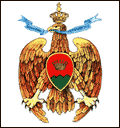|
Welcome to
Catanzaro
from Jesse's Journeys in Italy
Population: 101,000
Official site:
Catanzaro
Wikipedia:
Catanzaro
Map:
MapQuest
Catanzaro, founded by the
Byzantines in the 9th
Century to control the mountain
pass between the
Ionian Sea and the
Tyrrhenian Sea at
Calabria's narrowest point, is
the capital of
Calabria
and its eponymous Province.
Now,
Catanzaro is a mid-sized city,
whose economy is buoyed-up by
government employment and
spending, and a university.
However, for centuries starting
in the 11th century, Catanzaro
was involved in large scale and
sophisticated silkworm breeding
activities, and was the
lace and linen capital of the
world, supplying the Vatican and
many other royal and not so
royal courts around the world.
Catanzaro's ancient
centers sit on three hills (345
meters above sea level) split by
the deeply cut Valle
Fiumarella
overlooking the
Ionian Sea on
Calabria's eastern side.
The valley is spanned by one of
the highest steel bridges in
Europe.
At the very top of the highest
of these hills is a castle built
in 1060 by the
Norman conqueror, Roberto
il Guidscardo, after he
defeated the Byzantines,
and the now deconsecrated church
of San Omobono,
Gothic with
Baroque portals, built
in the 12th Century by the Sarti
Confraternity). The views
on any side of the hill top are
magnificent, at any time of
year.
Further down the hill, still in
the "old town" are other
churches in the Baroque style,
including the the Monte dei
Morti, the Chiesa di
Rosario, Chiesa San Giovanni,
and Chiesa d'Osservanza.
In the latter, there are
frescoes and paintings done in
the 16th Century, and a
beautiful Madonna by Gagini.
Palazzo Larussa (at one time
Palazzo Fassari) on Catanzaro's
main street, Corso Mazzini, is a
Florentine looking building that
was actually built in the 19th
century.
Those travelers who enjoy
traditional Italian festivals
should arrive at Easter for A
Naca, the Good Friday
procession during which
Catanzarese dress in biblical
garb and perform the Stages of
the Cross. In July, there
is a Feast of the Sailors'
Madonna festival. A
statue of the Madonna is floated
around town on a "barge" amidst
a flotilla of other decorated
"boats" bedecked with flowers
and garlands. During the
first 10 days of August, the
city puts on a one week market
where products and produce from
the entire Province of Catanzaro
are on display - and very much
for sale.
If one spends any time at all in
Catanzaro, one will work up an
appetite. In the old city,
the one dish highly recommended
for lunch is a traditional plate
called U Morseddu.
It's made of liver, peppers and
tomato sauce served on a
crustless ring of flat bread.
Other local dishes include A
Tiana (kidney, artichokes,
potatoes, peas, bread crumbs and
various spices); Sopressata,
a spicey sausage, and a variety
of cheeses, Pravola, Butirri and
Pecorino are among the best.
Sweets are devised of figs,
nuts, lemon and lemon peel,
sometimes candied. For
wines, the well-known (and
loved) rose Giro from
Crotone goes down well, but so
do the local wines made from
vintages grown on the slopes
near Catanzaro.
The City's seaside counterpart,
Catanzaro Lido, mostly a
seaside resort and small fishing
port, lies 5 kilometers
east on the Ionian coast. In
between, along the Via
Cassiodoro, are the newer
districts (Gagliano,
Pontepiccolo, Corvo, Aranceto)
with more modern buildings and
most of the light industries
that have spawned here in the
20th century, including
distilleries and flour mills.
On the road to Lamezia to
the west, higher than Catanzaro,
is the village of Caraffa,
a settlement founded by
Albanians where a dialect
heavily flavored by Albanian is
still spoken, and where men and
women don colorful traditional
costumes at almost every
festa.
At Caraffa one can
proceed to Lamezia, or fork
north to Tiriolo where at
the top of the village one can
look east to the Ionian Sea,
and west to the Tyrrhenian.
Artifacts left by Phoenecians
many centuries ago, attest to
the ages during which the area
has been "trod by man".
Tiriolo is also famous for its
weaving, particularly of
traditional Calabrian shawls.
Catanzaro itself is not the
prettiest of Calabrian towns.
It is, in some parts, down at
the heels, and, admittedly, much
of it is on the ugly
side. The reason is that
the City was virtually wiped-out
by earthquake in 1783, and
shaken badly all over again in
1832. Between the two
quakes, much of "beautiful"
Catanzaro was destroyed.
Still, Catanzaro has its
pleasures, treasures and
fascinations, and as
Calabria's capital city deserves
a visit. Compensation
comes from an open-minded
appreciation of its evolution
since ancient times. If
that is not sufficient,
remember, at Catanzaro Lido
one can swim, sail, scuba dive.
And, at nearby villages and
towns, which are not so sullied
by modernity, one can catch a
glimpse of Calabria at its most
elemental. And that's
something!
by
Vian Andrews September 14, 2005 |
|
Region of Calabria |
|
|
|
Directions |
|
By Car: SS228
from Lamezia; SS 106
from Reggio di
Calabria (south
west) and SS 106
from Crotone
(north).
Train/Bus:
from Lamezia and
Crotone.
Air: Fly to
Lamezia |
|
Directory |
| |
|
|

Modern offices,
Catanzaro |
|
|

Catanzaro Coat of
Arms |
|